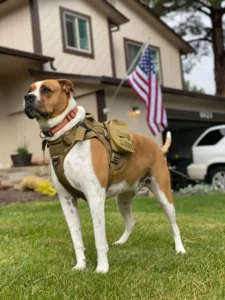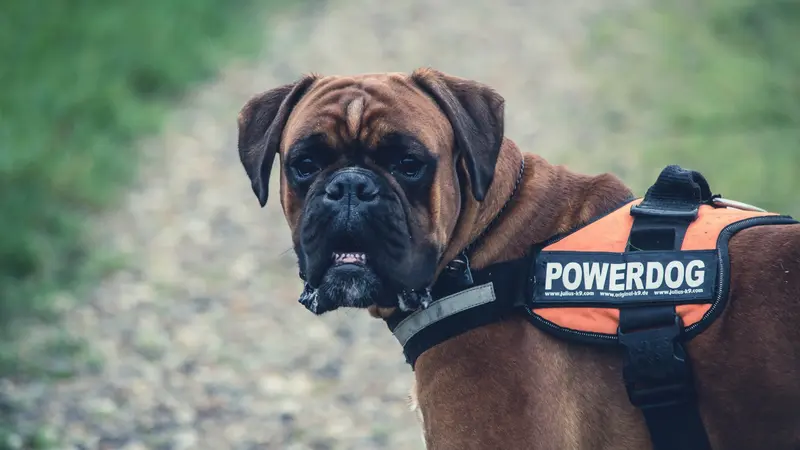Dogs have a long history of assisting their owners, from herding to hunting – it’s part of the reason why we love them so much. While most dogs these days are house pets, some dogs still perform valuable work for humans – most notably, service dogs.
Service dogs are more than just pets; they are vital companions and helpers to individuals with various needs. These dogs undergo specialized training to assist people with disabilities, including visual and hearing impairments, mental health disorders, mobility challenges, and more. The bond between a service dog and its handler is profound and often life-changing.
7 Most Popular Service Dog Breeds
i) Labrador Retriever
History and Characteristics: The Labrador Retriever, originating from Newfoundland, is renowned for its friendly demeanor, intelligence, and adaptability. These traits stem from their history as fishermen’s helpers, where they retrieved fish and helped in hauling nets.
Service Roles: Labradors are highly valued in various service roles. They excel as guide dogs for the visually impaired, given their steady temperament and eagerness to please. They are also widely used in search and rescue operations and as therapy dogs due to their gentle nature.
ii) Golden Retriever
History and Characteristics: Similar to Labradors, Golden Retrievers have a history of aiding hunters in retrieving game. They are known for their friendly, tolerant attitude and intelligence.
Service Roles: Golden Retrievers are popular as service dogs for individuals with disabilities. They are particularly effective in emotional support roles and as hearing dogs. Their calm demeanor makes them excellent for therapeutic settings, especially in hospitals and nursing homes.
iii) German Shepherd
History and Characteristics: Originally bred for herding and guarding sheep, German Shepherds are known for their courage, intelligence, and versatility. They are often perceived as one of the most intelligent dog breeds.
Service Roles: German Shepherds are widely used in police and military roles due to their strength, obedience, and ability to be trained for various tasks. They also serve as guide dogs and in mobility assistance roles.

iv) Poodle
History and Characteristics: Poodles, known for their hypoallergenic coats, were initially bred in Germany for retrieving waterfowl. They are brilliant and trainable, making them suitable for various service roles.
Service Roles: Poodles are often used for people with allergies. They excel in medical alert services, such as detecting diabetic emergencies or seizures. Their friendly and gentle nature also makes them suitable for therapeutic visitations.
v) Border Collie
History and Characteristics: Border Collies, known for their herding skills, originate from the Anglo-Scottish border region. They are considered one of the most intelligent dog breeds, excelling in agility and obedience.
Service Roles: Border Collies are often used in roles that require high levels of intelligence and agility, such as search and rescue missions. They are also effective in assisting individuals with psychiatric and neurological disorders due to their sensitivity and responsiveness.
vi) Cavalier King Charles Spaniel
History and Characteristics: This breed, known for its affectionate nature and elegant appearance, was a favorite among British royalty. They are friendly, patient, and good with children and other animals.
Service Roles: Cavalier King Charles Spaniels are excellent for emotional support and therapy, especially in settings like hospitals and nursing homes. They are also used for medical alert services, particularly for conditions like diabetes.
vii) Bernese Mountain Dog
History and Characteristics: Originally from the Swiss Alps, Bernese Mountain Dogs were used for herding cattle and pulling carts. They are known for their strength, calmness, and loyalty.
Service Roles: Their large size and gentle nature make them suitable for mobility assistance. They are also used in therapy roles, providing comfort and support with their friendly demeanor.
Training a Service Dog
Training a service dog is a complex, multifaceted process that requires patience, expertise, and a deep understanding of canine behavior. Let’s delve into what it takes to train these remarkable animals.
i) Selection and Early Socialization
Initial Assessment: The journey begins with selecting the right puppy. Breeds are chosen based on the specific service role, but individual temperament is crucial. Puppies destined to become service dogs are assessed for their sociability, confidence, and reaction to new experiences.
Socialization: Early socialization is critical. Puppies are exposed to various environments, sounds, and people to ensure they are comfortable and confident in different situations. This exposure helps prevent fear and anxiety, which are critical for a service dog’s effectiveness.
ii) Basic and Advanced Training
Obedience Training: The foundational stage of training involves basic commands like sit, stay, come, and heel. This basic obedience training establishes a baseline for discipline and responsiveness.
Specialized Skills: Depending on their intended role, dogs undergo training for specific tasks. For example, guide dogs for blind people learn to navigate obstacles, while medical alert dogs are trained to recognize and respond to specific medical cues.
iii) Positive Reinforcement Techniques
Reward-Based Training: Positive reinforcement is the cornerstone of service dog training. Dogs are rewarded with treats, praise, or play for correct responses. This method builds trust and encourages dogs to repeat desired behaviors.
Consistency and Patience: Trainers use consistent commands and rewards, ensuring that dogs understand what is expected of them. Patience is vital as dogs learn at different paces.
iv) Handler Training and Bonding
Handler Involvement: Once a dog has mastered specific skills, the handler is brought into the training process. This phase is crucial as it builds the bond between the dog and its future owner.
Team Training: The dog and handler learn to work as a team. Handlers are taught how to give commands, interpret the dog’s signals, and reinforce training in daily life.
v) Field Training and Public Access Skills
Real-World Exposure: Dogs are exposed to real-world scenarios to ensure they can perform their tasks reliably in different environments, such as crowded streets, public transportation, and various public settings.
Public Access Training: Dogs are trained to behave impeccably in public, including being calm around other people and animals, not seeking attention, and ignoring distractions.
vi) Continuous Training and Assessment
Ongoing Training: Training doesn’t end once a dog is placed with a handler. Continuous training ensures that the dog maintains its skills and adapts to any changes in the handler’s needs.
Regular Assessments: Service dogs undergo periodic evaluations to ensure they are performing their tasks effectively and to address any behavioral issues that may arise.
vii) The Impact of Training
The rigorous training process ensures that service dogs are reliable, responsive, and capable of performing complex tasks. It’s a journey that transforms a playful puppy into a dependable, skilled companion that can significantly enhance the quality of life for its handler.
Conclusion
The breeds discussed represent just a fraction of the many dogs that serve humans in various capacities. Each breed brings its unique set of skills and characteristics, making them suited for specific service roles.
From guiding the visually impaired to providing emotional support and saving lives in emergencies, service dogs profoundly impact the lives of their handlers and the communities they serve. Their training, loyalty, and dedication help thousands of people live more prosperous, more fulfilling lives.
